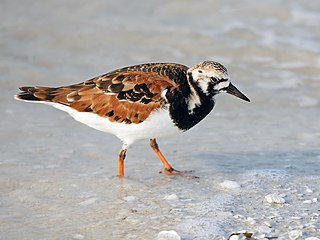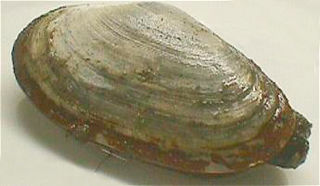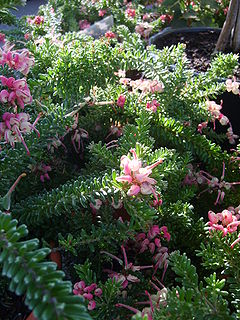Related Research Articles

Ammophila is a genus of flowering plants consisting of two or three very similar species of grasses. The common names for these grasses include marram grass, bent grass, and beachgrass. These grasses are found almost exclusively on the first line of coastal sand dunes. Their extensive systems of creeping underground stems or rhizomes allow them to thrive under conditions of shifting sands and high winds, and to help stabilize and prevent coastal erosion. Ammophila species are native to the coasts of the North Atlantic Ocean where they are usually the dominant species on sand dunes. Their native range includes few inland regions, with the Great Lakes of North America being the main exception. The genus name Ammophila originates from the Greek words ἄμμος (ámmos), meaning "sand", and φίλος (philos), meaning "friend".

Turnstones are two bird species that comprise the genus Arenaria in the family Scolopacidae. They are closely related to calidrid sandpipers and might be considered members of the tribe Calidriini.

The ruddy turnstone is a small wading bird, one of two species of turnstone in the genus Arenaria.

Soft-shell clams or sand gaper, scientific name Mya arenaria, popularly called "steamers", "softshells", "piss clams", "Ipswich clams", or "Essex clams" are a species of edible saltwater clam, a marine bivalve mollusk in the family Myidae.

Arenaria is a genus of flowering plants, within the family Caryophyllaceae.

Ammophila arenaria is a species of flowering plant in the grass family Poaceae. It is known by the common names marram grass and European beachgrass. It is one of two species of the genus Ammophila. It is native to the coastlines of Europe and North Africa where it grows in the sands of beach dunes. It is a perennial grass forming stiff, hardy clumps of erect stems up to 1.2 metres (3.9 ft) in height. It grows from a network of thick rhizomes which give it a sturdy anchor in its sand substrate and allow it to spread upward as sand accumulates. These rhizomes can grow laterally by 2 metres in six months. One clump can produce 100 new shoots annually.

Grevillea lanigera, commonly known as woolly grevillea, is a small shrub which is endemic to Victoria and New South Wales in Australia.

Quickella is a monotypic genus of land snail in the family Succineidae, the amber snails. It is known commonly as the sandbowl snail. The only species is Quickella arenaria.

Meloidogyne arenaria is a species of plant pathogenic nematodes. This nematode is also known as the peanut root knot nematode. The word "Meloidogyne" is derived from two Greek words that mean "apple-shaped" and "female". The peanut root knot nematode, M. arenaria is one of the "major" Meloidogyne species because of its worldwide economic importance. M. arenaria is a predominant nematode species in the United States attacking peanut in Alabama, Florida, Georgia, and Texas. The most damaging nematode species for peanut in the USA is M. arenaria race 1 and losses can exceed 50% in severely infested fields. Among the several Meloidogyne species that have been characterized, M. arenaria is the most variable both morphologically and cytologically. In 1949, two races of this nematode had been identified, race 1 which reproduces on peanut and race 2 which cannot do so. However, in a recent study, three races were described. López-Pérez et al (2011) had also studied populations of M. arenaria race 2, which reproduces on tomato plants carrying the Mi gene and race 3, which reproduces on both resistant pepper and tomato.

Grevillea arenaria, commonly known as sand grevillea or hoary grevillea, is a species of flowering plant in the family Proteaceae and is endemic to New South Wales. It is a spreading shrub with elliptic to egg-shaped leaves with the narrower end towards the base, and red, pink or orange flowers.

Fagivorina arenaria, the speckled beauty, is a moth of the family Geometridae. The species was first described by Johann Siegfried Hufnagel in 1767. It is found from most of central Europe to the Balkan Peninsula and Ukraine. In the south it is found up to Sicily and in the north to Sweden and Norway.

Dolichovespula arenaria, also known as the common aerial yellowjacket, sandhills hornet, and common yellow hornet, is a species of wasp within the genus Dolichovespula widely distributed in the North American continent.
Niebla arenaria is a fruticose lichen that grows along the Pacific Coast of North America in the fog regions of the northern peninsula of Baja California from near Colonet south to Morro Santo Domingo. The epithet, arenaria, is in regard to the species growing on sand.

Sandy iris is a species in the genus Iris; it is also in the subgenus of Iris and in the Psammiris section. It is a rhizomatous perennial, from Central Europe, found in Hungary, Austria, Romania, Czech Republic and Ukraine. It has grass-like leaves, a short stem and pale yellow flowers. It has had a mixed origin and was once Iris humilis subsp. arenaria, a subspecies of Iris humilis, until it was reclassified as a separate species. But many sources still state that it is either a synonym or subspecies of Iris humilis. It is cultivated as an ornamental plant in temperate regions.
Flammeovirga is a Gram-negative, aerobic, non-spore-forming and chemoorganotrophic genus from the family of Flammeovirgaceae which occur in marine environments.
Flammeovirga pacifica is a bacterium from the genus of Flammeovirga which has been isolated from deep sea sediments from the West Pacific Ocean.
Flammeovirga yaeyamensis is a bacterium from the genus of Flammeovirga which has been isolated from the seaweed Digenea simplex from the Yaeyama Islands on Japan.
Flammeovirga aprica is a bacterium from the genus of Flammeovirga which has been isolated from marine mud in Yugoslavia.
Flammeovirga kamogawensis is a bacterium from the genus of Flammeovirga which has been isolated from coastal seawater from Kamogawa in Japan.
Flammeovirga agarivorans is a Gram-negative, aerobic and motile bacterium from the genus of Flammeovirga which has been isolated from seawater from the Luhuitou fringing reef in China..
References
- 1 2 Parte, A.C. "Flammeovirga". LPSN .
- 1 2 3 "Flammeovirga arenaria". www.uniprot.org.
- ↑ "Details: DSM-28230". www.dsmz.de.
- ↑ George M., Garrity (2011). Bergey's manual of systematic bacteriology (2nd ed.). New York: Springer Science + Business Media. ISBN 0-387-68572-3.